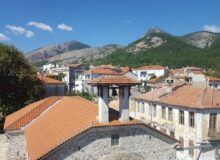The See Greece guide to the island of Aegina with a brief history and travel information on how to get there by ferry or by air and what to see and do.

Introduction
Aegina is one of the most enchanting Greek islands in the Saronic Gulf, known for its rich history, picturesque landscapes, and relaxed atmosphere. Located just a short ferry ride from Athens, it’s a perfect destination for a day trip or a longer getaway. With its charming port town, ancient temples, beautiful beaches, and delicious pistachios (a local specialty), Aegina offers a delightful mix of culture, nature, and relaxation.
This guide will cover:
– Where Aegina is located
– A brief history of the island
– Top sights and activities
– How to get there by air and ferry
Where is Aegina Located?

Aegina is part of the Saronic Islands, a group of islands in the Saronic Gulf near Athens. It lies approximately 27 km (17 miles) southwest of Athens’ port, Piraeus, making it one of the closest islands to the Greek capital.
Nearby Islands:
– Poros (to the south)
– Hydra (further southeast)
– Agistri (a tiny island just west of Aegina)
Due to its proximity to Athens, Aegina is a popular weekend escape for locals and tourists alike.
A Brief History of Aegina
Aegina has a long and fascinating history, dating back to Neolithic times (around 3500 BC). It was a major maritime and trade power in ancient Greece, even minting some of the earliest coins in Europe.
Key Historical Highlights:
– Ancient Times (3000–500 BC): Aegina was a rival to Athens and a significant naval power. The famous Temple of Aphaea (6th century BC) was built during this period.
– Classical & Roman Era (500 BC–300 AD): The island declined after Athens imposed heavy taxes, but it remained a cultural and religious center.
– Byzantine & Venetian Rule (300–1800 AD): Aegina was occupied by various empires, including the Byzantines and Venetians. The island’s medieval capital, Palaiochora, was a thriving town with over 300 churches.
– Greek War of Independence (1821–1829): Aegina briefly served as the first capital of modern Greece in 1827–1829 before Athens took over.
– Modern Era (20th–21st Century): Today, Aegina is a peaceful island known for tourism, fishing, and its famous pistachios.

What to See and Do on Aegina
1. Explore Aegina Town (Chora)
The island’s main port town is a charming mix of neoclassical buildings, lively cafes, and a bustling waterfront. Key highlights include:
– The Fish Market – A great spot to try fresh seafood.
– The Archaeological Museum – Houses artifacts from ancient Aegina.
– The Markellos Tower – A historic 19th-century landmark.

2. Visit the Temple of Aphaea
One of the best-preserved ancient Greek temples, the Temple of Aphaea (500 BC) sits atop a pine-covered hill with stunning views of the Saronic Gulf. It forms a sacred triangle with the Parthenon and the Temple of Poseidon at Sounion.
3. Discover the Monastery of Agios Nektarios
The largest church in Greece, this 20th-century monastery honors Saint Nektarios, a revered Orthodox saint. The complex includes a grand basilica and peaceful gardens.
4. Wander Through Palaiochora (The Ghost Town)
This abandoned medieval village was Aegina’s capital from the 9th to 19th centuries. Today, you can explore the ruins of 365 churches and chapels hidden among the hills.
5. Relax at Aegina’s Best Beaches
– Agia Marina – A family-friendly beach with shallow waters.
– Marathonas – A quieter pebble beach with tavernas nearby.
– Perdika – A fishing village with a scenic coastline.
– Souvala – Known for its thermal springs.
6. Taste Aegina’s Famous Pistachios
Aegina produces some of the best pistachios in Greece. Visit local shops to try:
– Roasted pistachios
– Pistachio butter
– Pistachio sweets (baklava, ice cream, liqueur)
7. Take a Boat Trip to Nearby Moni Island
A small uninhabited island near Aegina, Moni is a nature reserve with crystal-clear waters, perfect for swimming and snorkeling.
8. Visit the Tower of Kolona
Near Aegina Town, this lone column is all that remains of the Temple of Apollo (6th century BC). The site also includes an ancient acropolis and ruins.
9. Enjoy Local Cuisine
Don’t leave without trying:
– Fresh seafood (octopus, grilled fish)
– Pistachio-infused dishes
– Traditional Greek mezze

How to Get to Aegina
By Ferry
Aegina is easily accessible from Piraeus (Athens’ main port). Ferries run frequently, with two main types:
1. Conventional Ferries (1-hour trip, cheaper, carry vehicles)
2. Flying Dolphins (High-Speed Hydrofoils) (40-minute trip, more expensive)
Key Ferry Operators:
– Hellenic Seaways
– Aegean Speed Lines
– Saronic Ferries
By Air
Aegina has a small airport, but there are no scheduled commercial flights. The closest international airport is Athens International Airport (ATH), from where you can take a taxi, bus or metro to Piraeus (45 min) and then a ferry.
Getting Around Aegina
– Buses – Reliable and cheap, connecting major towns.
– Taxis – Available but limited; best to book in advance.
– Rental Scooters/Cars – Ideal for exploring remote beaches.
– Bicycles – A good option for short distances.

Final Tips for Visiting Aegina
– Best Time to Visit: April–October (July–August is busiest).
– Day Trip Possible? Yes, but staying overnight is recommended.
– Currency: Euro (€).
– Language: Greek, but English is widely spoken.





















